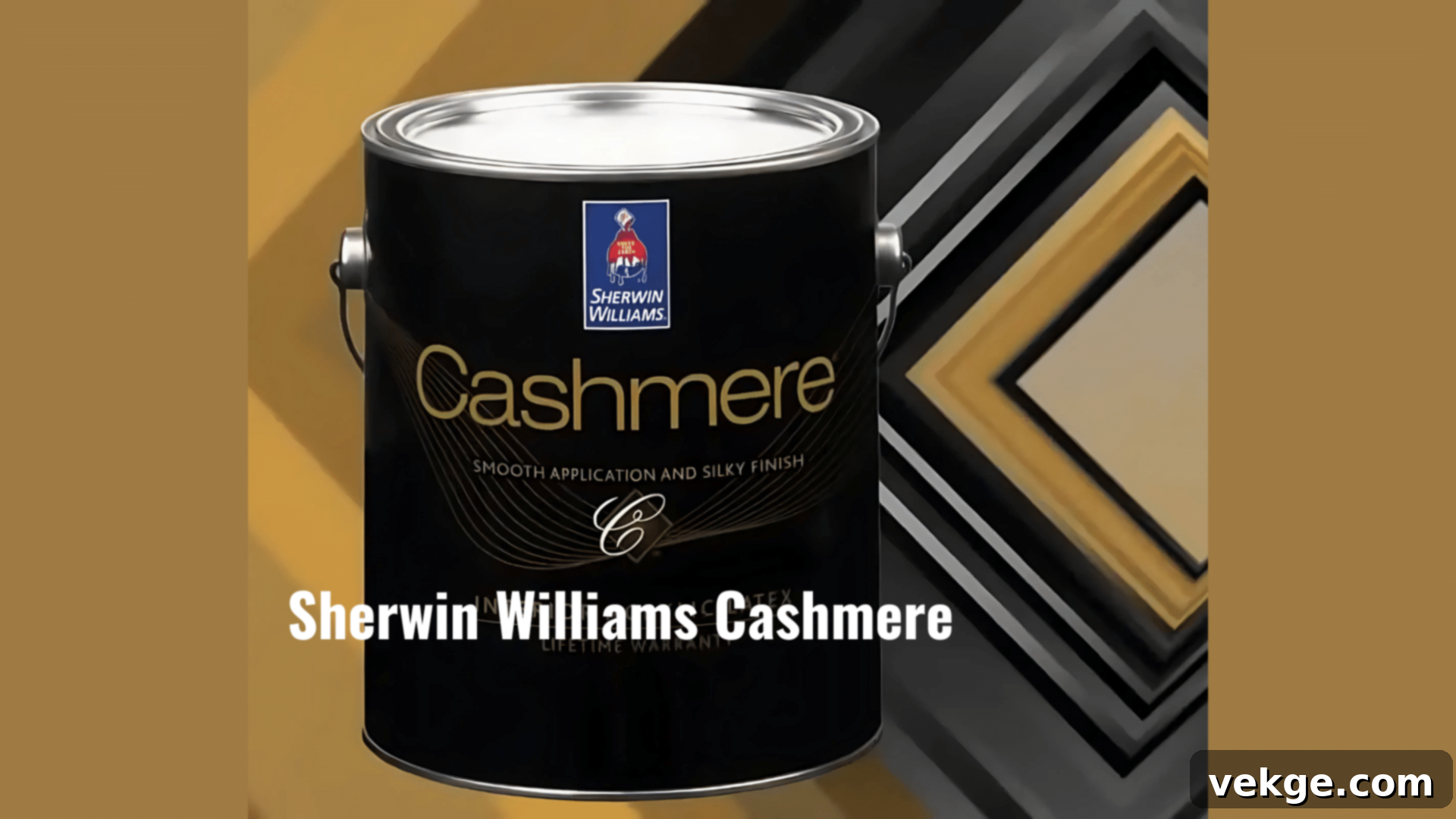Sherwin-Williams Cashmere Paint: The Ultimate Guide to a Flawless, Buttery-Smooth Finish for Your Home
Sherwin-Williams Cashmere paint has emerged as a top choice for homeowners, and for excellent reasons. This premium interior paint is celebrated for its ability to deliver an exceptionally smooth, professional-looking finish with remarkable ease. Unlike standard paints, Cashmere offers a distinctive aesthetic that elevates any room, making it a favorite among DIY enthusiasts and professional painters alike.
Upon drying, walls painted with Cashmere possess a luxurious, soft-to-the-touch feel that many notice immediately. This unique tactile quality, combined with its visual elegance, sets Cashmere apart, creating an inviting and refined atmosphere in your living spaces.
Beyond its luxurious feel, Cashmere boasts superior coverage. Most painting projects require only two coats to achieve full, vibrant color, significantly reducing the need for a third application often necessary with other paint brands. This efficiency saves both time and effort, making your painting process smoother and faster.
One of Cashmere’s most impressive features is its self-leveling property. As the paint dries, it naturally smooths itself out, effectively minimizing visible brush marks, roller textures, and minor imperfections around trim work. This ensures a consistent, even appearance across your walls, contributing to that coveted professional finish.
While Sherwin-Williams Cashmere may carry a higher price tag than more basic paint options, the superior results—including its buttery-smooth finish, excellent coverage, and lasting durability—consistently justify the investment. It’s a choice that pays off in the long run, transforming your home with a high-end look.
This comprehensive guide will cover everything you need to know to successfully use Sherwin-Williams Cashmere paint. From essential preparation techniques to expert finishing tips, we’ll help you achieve the best possible results for any painting project, ensuring your walls look stunning and last for years to come.
Understanding Sherwin-Williams Cashmere: Features and Benefits
Sherwin-Williams Cashmere is an interior acrylic latex paint specifically formulated to provide a luxurious, smooth finish on walls and trim inside your home. It’s a paint designed not just for color, but for an exceptional tactile and visual experience.
This paint is renowned for its ease of application, making it a dream to work with for both experienced painters and first-time DIYers. It glides on effortlessly, resulting in walls that look soft, elegant, and beautifully uniform. Cashmere is available in Sherwin-Williams’ vast array of colors, ensuring you can find the perfect shade to match your home’s aesthetic and personal style.
Cashmere paint comes in several sheens to suit various preferences and functional needs:
- Flat: Offers a non-reflective, velvety look, ideal for hiding wall imperfections and creating a sophisticated, subdued atmosphere. Best for low-traffic areas like formal dining rooms or ceilings.
- Low Lustre: A subtle, soft sheen that adds a touch of elegance without being too reflective. It’s a great choice for living rooms and bedrooms, offering a bit more durability than flat.
- Eggshell: Provides a soft, subtle glow, making it a popular choice for most interior walls. It’s more durable and easier to clean than flat or low lustre, perfect for family rooms and hallways.
- Satin (or Pearl): Offers a more noticeable sheen, reflecting light beautifully. This finish is highly durable and very easy to clean, making it an excellent option for high-traffic areas like kitchens, bathrooms, and kids’ rooms where frequent wiping is necessary.
One of the paint’s most significant advantages is its excellent coverage. It effectively conceals minor wall imperfections and existing colors with fewer coats, often requiring just two for a flawless finish. The self-leveling properties ensure that brush strokes and roller marks virtually disappear as the paint dries, leaving behind a smooth, even surface. This attribute is particularly beneficial for achieving a professional appearance without streaking or uneven textures.
Furthermore, Cashmere paint is engineered for easy maintenance. Its durable finish, particularly in higher sheens like Satin/Pearl, allows for effortless cleaning of smudges and spills, keeping your walls looking fresh and new. Many homeowners appreciate its low odor formula, which makes painting a more pleasant experience and minimizes disruption to daily life. It’s a safe and suitable choice for creating cozy, fresh, and beautiful environments in any indoor space.
Transforming Your Home: Using Sherwin-Williams Cashmere in Different Rooms
Sherwin-Williams Cashmere offers a smooth, stylish, and durable finish that works beautifully across various rooms in your home. Its versatility allows it to adapt to different lighting conditions and functional requirements, enhancing the overall ambiance of each space.
1. Cashmere in Living Rooms: Creating an Inviting Atmosphere
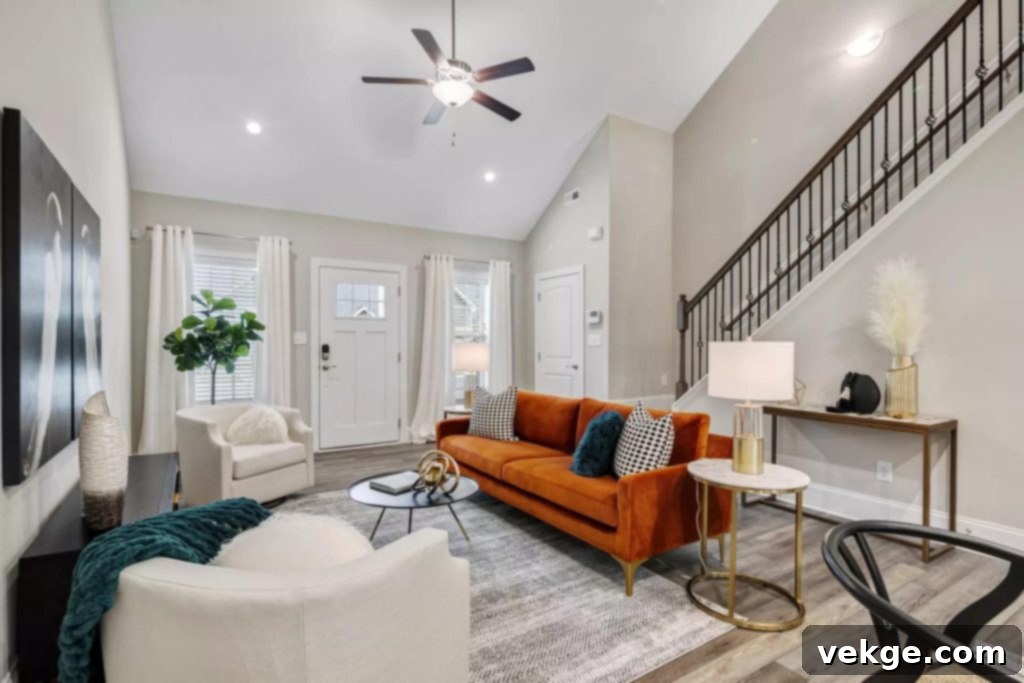
My living room makeover with Cashmere Agreeable Gray last month truly exceeded all my expectations. Despite some minor imperfections on the old walls, the paint’s rich texture and self-leveling properties worked wonders, making them appear incredibly smooth and flawless. This transformed the entire feel of the room, giving it an immediate upgrade.
I particularly love how the natural light interacts with the paint throughout the day. In the mornings, the soft glow brings out a subtle warmth in the Agreeable Gray, creating a cheerful and inviting start to the day. As evening approaches, the same color takes on a deeper, more comforting hue, providing a soft, welcoming ambiance perfect for relaxation or entertaining. The versatility of Cashmere allows the color to adapt beautifully to changing light conditions, always presenting a refined and elegant look.
2. Applying Cashmere in Bedrooms: Achieving Serenity and Seamlessness
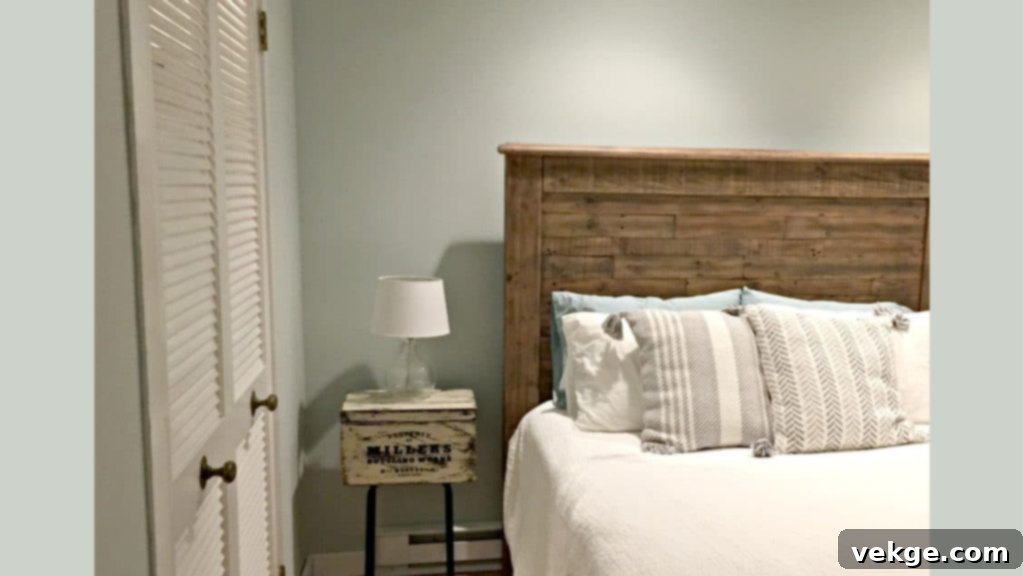
My bedroom was the next project on the list, and I opted for the soothing Cashmere Sea Salt. My primary concern was the strong morning light streaming through my windows, which I feared would highlight any unsightly brush marks. However, the paint’s exceptional self-leveling capability truly shone here, leaving an incredibly smooth and seamless finish that completely alleviated my worries.
While Cashmere is known for its excellent coverage, I found that near the windows, one coat wasn’t quite sufficient to achieve the depth of color I desired, particularly where the light was most intense. Therefore, I applied two full coats, which resulted in perfect, uniform coverage and a beautifully consistent hue. I chose a flat finish for the bedroom, which proved to be an excellent decision. This matte surface absorbs light rather than reflecting it, creating a sense of expansiveness and a deeply peaceful atmosphere that is ideal for a restful retreat. The subtle texture of the flat Cashmere also adds a layer of understated luxury to the room.
3. Using Cashmere in Kitchens & Busy Areas: Durability Meets Elegance
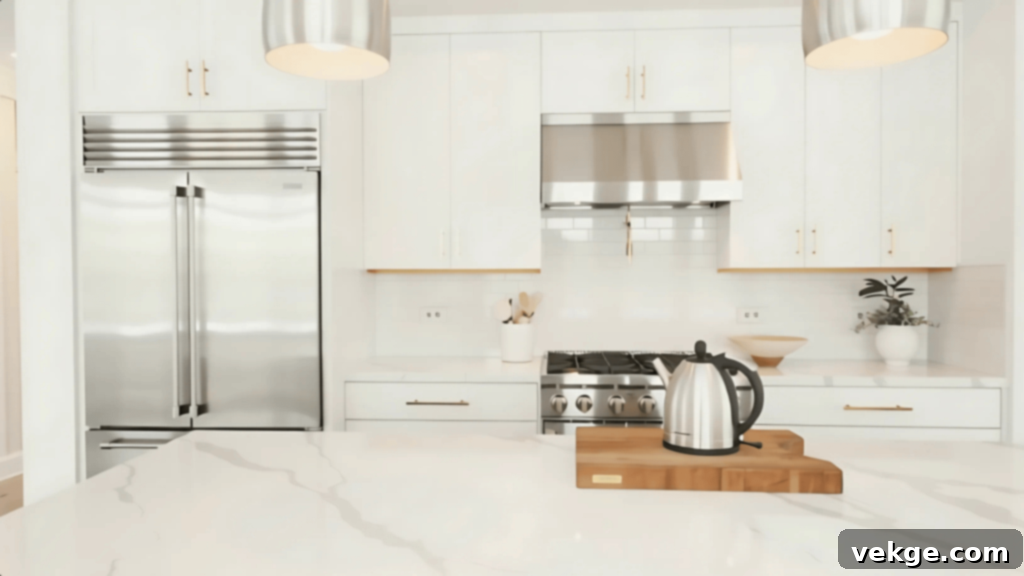
My kitchen makeover provided a thorough test of Cashmere’s impressive durability. For this high-traffic, high-activity area where I cook daily, I specifically chose the Pearl Finish. This sheen is known for its excellent resistance to stains and its ease of cleaning, which is essential for walls that require frequent wiping down. After three months of regular cooking and subsequent cleaning, the walls still look remarkably fresh and vibrant, a testament to the paint’s robust quality.
An important lesson I learned, especially in areas near the stove, was the absolute necessity of thoroughly cleaning the walls with Trisodium Phosphate (TSP) before painting. Any missed grease spots, no matter how small, tended to show through the fresh paint, compromising the finish. Proper preparation in busy, grease-prone areas is paramount for achieving a truly lasting and flawless result with Cashmere.
Despite these challenges, the paint covered my old, darker wall color in just two coats, which was a significant time and cost saver. This exceptional coverage meant I didn’t need to purchase additional gallons or spend extra hours on a third coat. The smooth finish made the kitchen feel instantly brighter and more modern.
Expert Tip for Cashmere Application: I discovered that Cashmere dries notably faster than many other paints I’ve used. To maintain a consistent “wet edge” and avoid lap marks, it’s crucial to work in smaller sections, especially when covering larger wall areas. This technique helps ensure an even, seamless application and prevents noticeable transitions between painted sections.
Harmony in Hues: Pairing Sherwin-Williams Cashmere with Other Colors
Sherwin-Williams Cashmere’s soft, refined finish provides a perfect canvas for a wide array of color palettes, allowing it to harmonize beautifully with various accent shades and tones. Its inherent elegance enhances any complementary color, creating cohesive and inviting spaces.
1. Best Accent Colors for a Complete Look: Defining Your Space
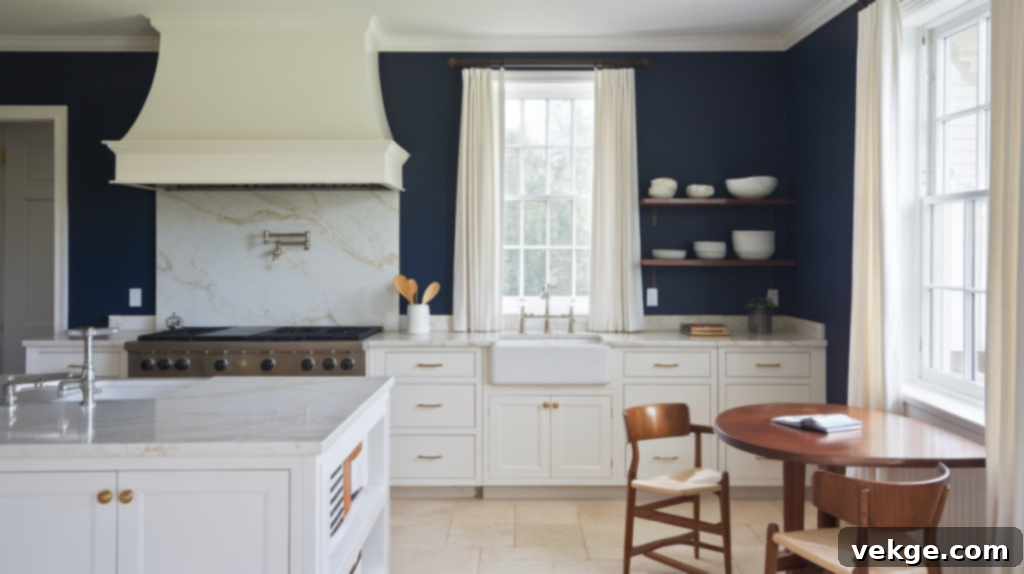
After successfully painting my main walls with the crisp and clean Cashmere Pure White, I dedicated several weeks to meticulously testing various accent colors. This extensive trial-and-error process allowed me to discover combinations that truly elevate the space without clashing.
My absolute favorite combination emerged in the dining room, where a striking accent wall painted in Naval Blue created a sophisticated yet harmonious contrast against the Pure White. The deep, rich tone of Naval Blue provides an anchor for the room, making the white walls feel even more expansive and bright without any jarring transitions. This pairing exemplifies how Cashmere’s smooth finish allows bolder colors to shine beautifully.
Through continued experimentation, I also found that using Repose Gray for trim work provided a subtle, clean separation between different wall colors and the ceiling. This neutral gray offers a sophisticated boundary that defines architectural elements without competing for attention, whether paired with light or dark walls. For homeowners looking to make a statement with a dark accent wall, Naval Blue is an exceptional choice. Conversely, for those preferring a lighter, more ethereal accent, Repose Gray delivers an elegant and understated solution.
2. Pairing Cashmere with Bold and Subtle Tones: Striking the Perfect Balance
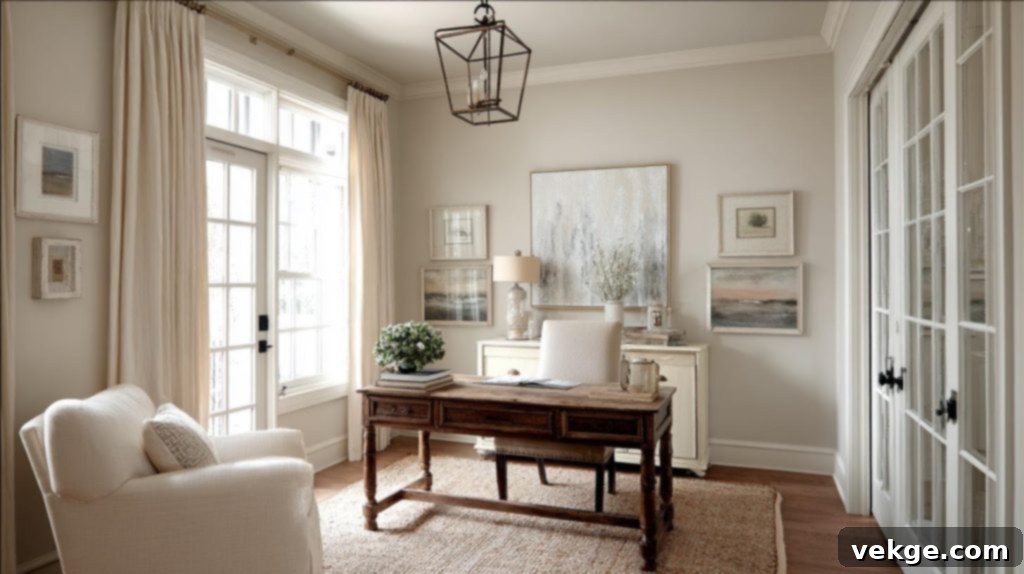
For my home office, I took a calculated risk by pairing the serene Cashmere Alabaster walls with an accent of Iron Ore. This deep, charcoal-like hue could easily overwhelm a smaller space, but Cashmere’s soft, forgiving finish skillfully balanced the bold color, preventing it from feeling too heavy or stark. The Alabaster provided ample “breathing room,” allowing the darker tone to act as a sophisticated accent rather than a dominating presence.
In contrast, for my guest bathroom, I opted for an even lighter and airier approach. I matched Cashmere Snowbound, a crisp, clean white, with subtle touches of Dried Thyme in the vanity area. This soft, earthy green provided just enough color to add interest without detracting from the peaceful simplicity of the Snowbound walls. It created a spa-like tranquility that guests frequently compliment.
The key lesson I consistently learned from these varied projects is that bold colors, while impactful, require ample neutral space to truly shine. Whether it’s a large wall or a small accent, ensuring plenty of Cashmere’s neutral tones surround stronger colors helps to maintain balance, sophistication, and a harmonious overall design. This approach prevents rooms from feeling claustrophobic or overly stimulating, allowing each color to contribute effectively to the aesthetic.
3. Adding Texture and Warmth to Cashmere with Wood and Fabrics: A Multi-Sensory Approach
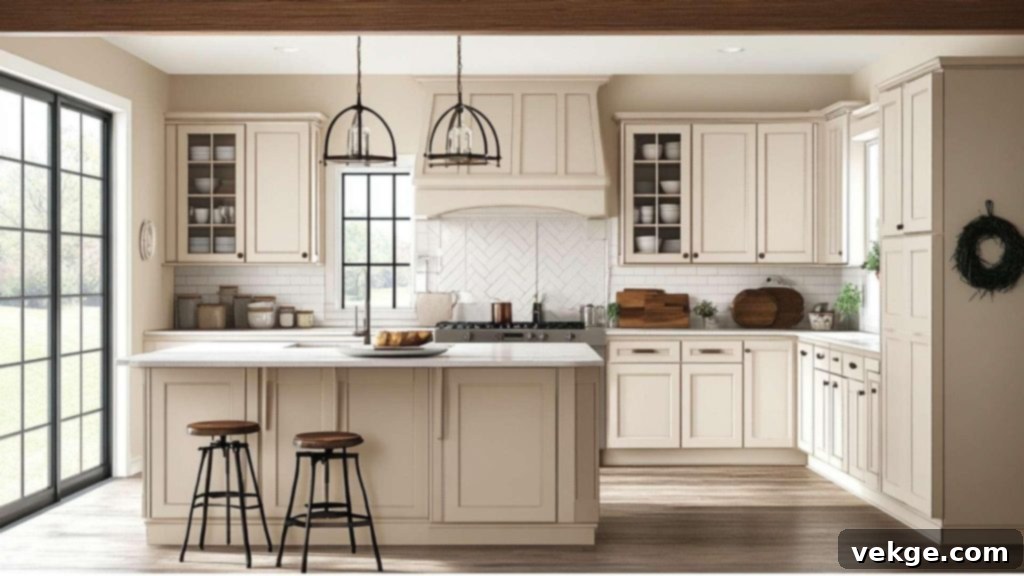
Cashmere paint serves as an exceptional backdrop for integrating diverse textures and natural materials, enhancing a room’s depth and comfort. For instance, the rich, warm tones of oak furniture truly pop against the subtle elegance of Cashmere White Duck walls, creating a sophisticated and inviting contrast. Similarly, flowing linen curtains in a warm beige hue blend seamlessly with the paint’s soft finish, adding an airy yet grounded feel to the space.
Imagine Greek Villa walls paired with chunky knit throws and plush rugs; this combination instantly crafts cozy reading nooks or comfortable lounging areas. The deliberate mix of varied textures—from smooth paint to rough wood and soft fabrics—is crucial for making rooms feel more inviting, lived-in, and ultimately, more comfortable. This multi-sensory approach adds character and visual interest that flat surfaces alone cannot achieve.
When selecting Cashmere colors and complementary elements, it’s vital to consider the existing flooring and the natural and artificial lighting in each room. For example, a crisp shade like Extra White will appear distinctly different when set against dark walnut floors compared to lighter maple flooring. The undertones in the wood can dramatically alter how the paint color is perceived. Furthermore, strategic lighting can greatly influence the mood. Warm LED lights, for instance, can help cooler Cashmere shades, such as a pale gray, maintain their crispness without appearing cold or stark, adding a welcoming glow.
Mixing finishes also contributes significantly to a room’s depth. A matte Cashmere finish on walls provides a beautiful contrast when paired with glossy furniture pieces or polished metal accents. This interplay between reflective and non-reflective surfaces creates dynamic visual interest, preventing the room from feeling one-dimensional and enhancing its overall sophistication.
Pro Tip for Color Selection: To make the best color choices, always keep paint samples on small poster boards or large swatches. Move them around to different walls in your room at various times of the day. Observe how the color changes under morning sun, midday brightness, and evening artificial light. This simple step can prevent costly mistakes and ensure your chosen Cashmere shade looks perfect in all conditions.
Exceptional Advantages: Benefits of Choosing Sherwin-Williams Cashmere Paint
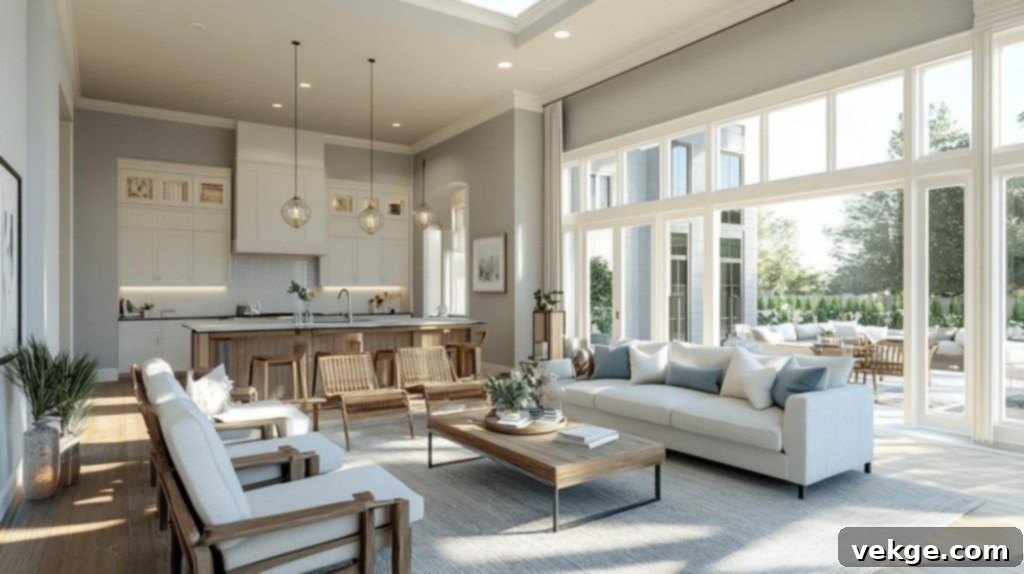
Sherwin-Williams Cashmere offers homeowners far more than just excellent coverage; it provides a comprehensive package of superior features that contribute to a truly refined and durable finish, standing out distinctly in any room of your home. Here’s a detailed look at the key benefits:
- Achieves a Luxurious, Smooth Finish: Cashmere’s advanced formula is designed to self-level, effectively hiding brush marks, roller textures, and minor wall imperfections. This results in a truly smooth, soft finish that looks impeccable, even under harsh direct sunlight or in high-traffic areas like hallways and entryways where flaws are easily exposed.
- Renovates Older Walls Effortlessly: This paint has a remarkable ability to make older, less-than-perfect walls appear fresh, updated, and new. Its thick, yet smooth consistency often means less intensive sanding or extensive prep work is required, significantly saving time, effort, and reducing the overall complexity of your painting project.
- Superior Stain Resistance and Easy Cleanability: Opting for a Pearl finish or higher dramatically increases the paint’s resistance to stains and makes cleaning remarkably easy. This characteristic makes Cashmere an ideal choice for demanding environments such as kitchens, bathrooms, playrooms, and other areas prone to frequent spills and messes.
- Exceptional Durability for Everyday Life: Cashmere is engineered to withstand the rigors of daily wear and tear. It holds up exceptionally well against the inevitable bumps, scuffs, and impacts from kids, pets, and general household activity. This robust durability ensures that your walls maintain their pristine look for months and even years without noticeable fading, chipping, or chalking.
- Enhances Lighting and Ambiance: The unique finish of Cashmere interacts beautifully with both natural and artificial lighting. It imparts a soft, inviting glow to walls, making rooms feel cozier, brighter, and more polished throughout the day. This subtle luminosity contributes significantly to the overall warmth and welcoming feel of your home.
- Provides a “Photo-Ready” Aesthetic: Thanks to its flawless and consistent appearance, Cashmere makes your walls look perfectly finished and refined, even in casual or challenging lighting conditions. This makes it an excellent choice for rooms where a polished look is paramount, such as home offices used for video calls, living rooms featured in online listings, or any space where visual appeal is highly valued.
- Offers a Distinctively Soft Tactile Experience: Beyond its visual appeal, Cashmere feels wonderfully soft to the touch when dry. This subtle luxury adds an unexpected layer of comfort and sophistication to everyday spaces, providing a high-end sensory experience while still being tough and practical enough for real-life demands.
- Delivers Long-Term Value and Reduced Maintenance: While it may be a premium product, Cashmere offers excellent long-term value. Its strong coverage, enduring durability, and resistance to wear mean a reduced need for frequent touch-ups or costly repaints. This longevity translates into significant savings and less hassle over time.
For those seeking paint that combines unparalleled beauty, lasting durability, and straightforward upkeep, Sherwin-Williams Cashmere consistently delivers a high-end finish without the typical challenges associated with premium paints. It’s an investment in the aesthetic and longevity of your home.
Sherwin-Williams Cashmere in Various Design Styles: A Versatile Choice
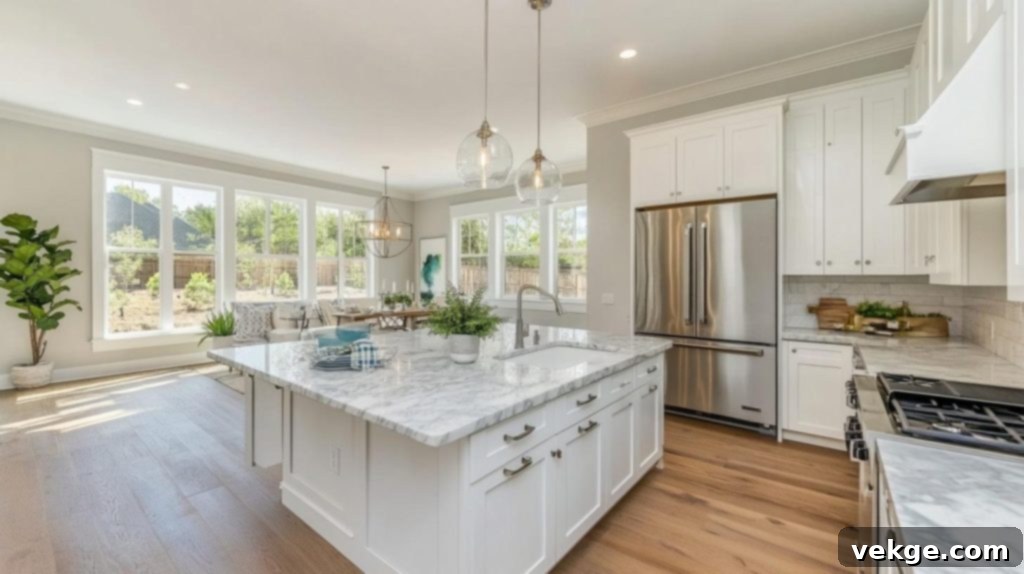
Sherwin-Williams Cashmere’s signature smooth finish and soft, understated look make it an incredibly versatile paint, perfectly suited for a wide array of interior design styles. Whether your home leans towards traditional elegance, sleek modernism, or rustic charm, Cashmere provides a foundational beauty that complements and elevates your chosen aesthetic.
| Design Style | Cashmere Color(s) Used | Key Features and Visual Effects |
|---|---|---|
| Classic & Traditional | Creamy White, Accessible Beige, Agreeable Gray | Cashmere’s soft sheen beautifully highlights intricate architectural details like crown molding, wainscoting, and classic furniture. Its subtle warmth pairs exquisitely with antique brass fixtures, rich dark wood tones, and traditional patterns, creating an enduring sense of grace and sophistication. |
| Modern & Contemporary | Pure White, Tricorn Black, Repose Gray | The smooth, flawless finish of Cashmere is ideal for modern and contemporary spaces, where clean lines and minimalist aesthetics prevail. It provides a crisp, bold backdrop for modern art and furniture, while its subtle depth interacts with minimalist lighting to add a nuanced visual interest without overwhelming the space. |
| Coastal & Farmhouse | Sea Salt, Alabaster, Pure White, White Duck | Cashmere’s light and airy colors perfectly capture the relaxed, inviting essence of coastal and farmhouse designs. It complements natural textures like shiplap, exposed wood beams, and wrought iron accents without competing for attention, creating a serene and breezy atmosphere that feels both fresh and authentic. |
| Eclectic & Transitional | Varies by room and materials (e.g., Anew Gray, Requisite Gray) | Cashmere’s adaptable nature makes it an excellent choice for eclectic and transitional styles, where different eras and elements are blended. It acts as a unifying backdrop, looking sleek and refined with modern pieces while also providing a soft, natural complement to rustic or vintage elements, helping to create cohesive yet diverse interiors. |
Regardless of your personal style or interior design vision, Sherwin-Williams Cashmere offers a finish that subtly supports and enhances your decor, allowing the unique character of your space to shine without ever being overshadowed by the paint itself. It’s the understated luxury that brings your entire design together.
Achieving Perfection: How to Sample & Test Sherwin-Williams Cashmere in Your Home
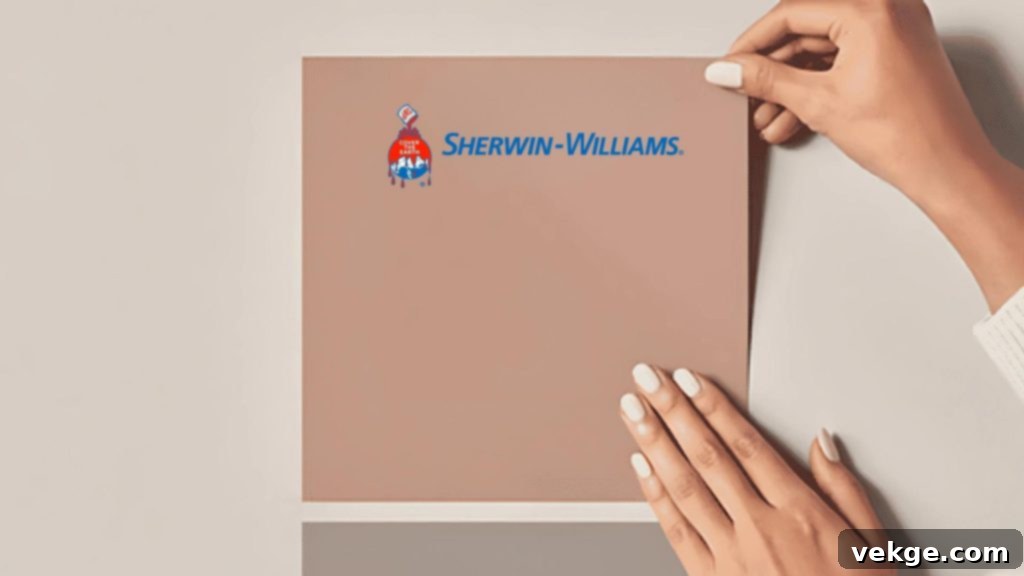
Sampling Sherwin-Williams Cashmere directly in your home environment is the most critical step to ensure your chosen color and finish perfectly complement your unique lighting, existing decor, and overall desired aesthetic. This process helps you visualize the true impact of the paint before committing to a large purchase.
1. Ordering Sherwin-Williams Paint Samples for Accurate Testing: Don’t Guess, Test!
After experiencing a few costly color mistakes in past painting projects, I quickly learned that proper testing is non-negotiable, especially with a premium paint like Cashmere. My journey to finding the perfect shade always begins by getting large color swatches from my local Sherwin-Williams store. While these provide a good starting point, they are not enough.
The crucial step is to ask for actual paint samples mixed specifically in Cashmere’s unique formula. This typically costs around $10 per sample, but it is an invaluable investment that saves you from the significantly higher cost and hassle of buying gallons of the wrong color. The store staff can mix small amounts of two or three different shades you are considering. This is absolutely key because colors often look different when rendered in Cashmere’s distinctive smooth finish compared to standard paint lines or even other Sherwin-Williams formulas. Always specify that you want the sample in Cashmere’s base.
2. Viewing Cashmere in Different Lighting for the Perfect Look: Light is Everything
When I tested Cashmere Agreeable Gray for my living room, I meticulously documented how the color appeared at various times throughout the day. This diligent approach was instrumental in preventing any unpleasant surprises after the full application. I made sure to apply samples to each wall, particularly those facing different directions, and observed them carefully at sunrise, midday, and sunset. I quickly noticed that the north-facing wall, which receives cooler, indirect light, made the gray appear slightly cooler and more subdued. Conversely, the south-facing wall, bathed in warmer, direct sunlight, brought out a subtle warmth and richness in the Agreeable Gray.
What truly enhanced my decision-making process was taking photos with my smartphone at different times. The camera often captured nuances and shifts in color that my eyes might have missed in the moment. Furthermore, I made it a point to test how the paint looked with my lamps and overhead lighting on at night. Since this is when I spend the majority of my time in the living room, ensuring the color felt right under artificial light was supremely important for creating the desired cozy and inviting evening ambiance.
3. Testing Swatches to Visualize Cashmere’s Effect on Your Home: The Poster Board Method
My single best testing tip, learned through hard-won experience, involves painting large swatches on movable surfaces. Instead of directly painting small spots on your wall, I highly recommend painting 2-foot by 2-foot squares on large white poster boards or sturdy foam core boards. This innovative method offers unparalleled flexibility, allowing you to easily move the samples around your rooms, testing them on different walls and in various corners throughout the day.
With these movable swatches, you can place them directly next to your furniture, curtains, area rugs, and existing trim to truly visualize how all the elements will harmonize together. The poster board method also simplifies testing different Cashmere finishes; I often tried a matte finish next to a pearl finish to see which one offered the desired balance of look and durability for a specific area. I lived with these samples for a full week, sometimes even longer, before making my final decision. This extended observation period is critical as colors evolve with changing light and personal mood.
One detail that proved incredibly helpful was placing samples directly against my baseboards and crown molding. I noticed that Cashmere’s finish, particularly its smoothness, can look subtly different when contrasted with other painted surfaces or different sheens already present in the room. Similarly, testing my samples against my flooring—whether hardwood, carpet, or tile—was eye-opening. A color I adored on the wall often looked completely different and sometimes clashed when placed near my rich hardwood floors, revealing undertones I hadn’t initially perceived.
Even after painting, I made a habit of keeping my leftover samples. They have proven invaluable for quick touch-ups down the line and for referencing colors when planning subsequent rooms or design updates. Looking back, the time, effort, and small investment I put into comprehensive testing saved me from potentially expensive mistakes and ensured I absolutely loved the final look of my Sherwin-Williams Cashmere walls.
Crucial Testing Insight: I found that painting two coats on my test squares made a monumental difference. The first coat, particularly with lighter colors, often did not accurately represent the true depth of color or the unique smoothness of Cashmere’s finish. However, the second coat always provided a far more accurate and realistic preview of how my finished walls would truly appear, making it an essential step in the sampling process.
Preserving Perfection: Maintenance Tips for Sherwin-Williams Cashmere Paint
Keeping your Sherwin-Williams Cashmere paint looking fresh, elegant, and new for years to come requires consistent, yet simple, care and prompt attention to any spills or marks. Its durable nature makes maintenance relatively easy, but a proactive approach yields the best results.
- Act Quickly on Spills: For most fresh spills and smudges, immediate action is key. Gently clean the area with a soft microfiber cloth dampened with plain, lukewarm water. This minimalist approach is often sufficient to remove marks without damaging the paint finish.
- Tackling Tougher Marks: For more stubborn blemishes like crayon marks, fingerprints, or light scuffs, use a microfiber cloth with warm water and a very mild dish soap. Apply the solution sparingly, gently wipe the area, and then lightly blot with a clean, damp cloth to remove any soap residue. Avoid abrasive cleaners or harsh scrubbing, especially on lower sheens.
- Store Leftover Paint Properly: Keep small, clearly labeled containers of leftover paint. Include the exact color name, sheen, and the room where it was used. Store them in a cool, dry place away from extreme temperatures to ensure the paint remains viable for future touch-ups.
- Mastering Touch-Ups: Before applying touch-up paint, ensure the area is completely clean and dry. For optimal blending, use the same application method (brush or roller) that was used for the original coat. Apply thin, even layers, feathering the edges to minimize visible lines between the old and new paint.
- Always Test Cleaning Methods: Before attempting any new cleaning method on a visible wall section, test it in an inconspicuous area. Behind a door, inside a closet, or behind a large piece of furniture are ideal spots to ensure the cleaner or technique won’t discolor or damage the Cashmere finish.
- Regular Light Dusting and Inspection: Integrate a light dusting of your walls into your weekly cleaning routine. Use a soft, dry microfiber cloth or a duster with an extendable handle. Every few months, take a moment to closely inspect your walls for any areas that might benefit from a minor touch-up or a gentle wipe-down, addressing small issues before they become more noticeable.
By incorporating these small, regular maintenance tasks, you can effortlessly preserve the pristine, luxurious appearance of your Sherwin-Williams Cashmere painted walls, ensuring they continue to look like new for many years.
Conclusion: The Enduring Appeal of Sherwin-Williams Cashmere
Sherwin-Williams Cashmere paint consistently delivers professional-grade results, making it an exceptional choice for homeowners who aspire to achieve smooth, clean-looking, and luxuriously finished walls. Its unique formulation and premium qualities set it apart in the market, transforming ordinary interiors into refined spaces.
While the initial cost of Cashmere paint may be higher than more basic alternatives, its superior quality quickly becomes evident through both its stunning appearance and its lasting durability. It represents a smart investment in your home’s aesthetic and longevity, offering a return that far outweighs the upfront expense.
Cashmere performs admirably across various rooms and conditions within the home. Its smooth application, remarkable ability to hide minor wall imperfections, and impressive self-leveling properties ensure a flawless finish every time. Even with regular cleaning, the paint maintains its fresh, vibrant appearance, a testament to its robust formulation. It’s not uncommon for homeowners to receive compliments on their beautifully painted walls many months, even years, after the project is completed.
Achieving success with Cashmere, like any premium product, hinges on proper preparation and meticulous color testing in the actual space. Recognizing that different lighting conditions, room orientations, and existing flooring can profoundly affect how colors appear is crucial. This makes the sampling and testing process, as detailed in our guide, an indispensable step for confidently selecting the perfect shade and sheen for your home.
For those who desire a paint that creates a sophisticated, finished, and clean aesthetic without an excessive sheen, Sherwin-Williams Cashmere offers outstanding value. Its distinctive smooth finish and enduring quality make it a highly reliable and rewarding choice for any home renovation or decorating project, guaranteeing a beautiful result that you’ll cherish for years.
Frequently Asked Questions (FAQs) About Sherwin-Williams Cashmere Paint
What Makes Cashmere Different from Other Sherwin-Williams Paints?
Sherwin-Williams Cashmere stands out primarily due to its unique self-leveling quality and advanced formula, which combine to create an exceptionally smooth, soft, and buttery finish. This attribute effectively hides brush marks, roller textures, and minor wall imperfections, leaving your walls looking remarkably clean, uniform, and professionally painted. It offers a luxurious tactile and visual experience that differentiates it from other lines.
Can I Use Cashmere Paint in a Bathroom?
Yes, Cashmere paint can be successfully used in bathrooms. However, for areas with higher moisture and humidity, it is strongly recommended to choose a Pearl finish (Satin) or higher. These sheens offer enhanced moisture protection and are much easier to clean. Additionally, ensuring the bathroom is well-ventilated, ideally with an exhaust fan, will significantly help the paint last longer and prevent mildew growth.
How Many Coats of Cashmere Paint Will I Need?
For optimal coverage, depth of color, and the most durable, even finish, two coats of Sherwin-Williams Cashmere paint are generally recommended. While Cashmere has excellent hiding power, applying two full coats ensures a consistent hue and maximizes its self-leveling benefits. In some instances, particularly when painting over a very light existing color with a new, equally light shade, one thick, carefully applied coat might suffice for smooth, lasting color, but two coats will always provide the best results.
Is Cashmere Paint Worth the Higher Price?
Many homeowners and professionals agree that Sherwin-Williams Cashmere paint is absolutely worth its premium price. Its superior attributes, including exceptional coverage (often requiring fewer coats), remarkable durability, self-leveling properties that eliminate brush marks, and a luxuriously smooth finish, contribute to a high-end look and feel that lasts longer. This often translates to fewer future touch-ups or repaints, making it a smart and cost-effective choice compared to lower-priced paints that may require more coats, frequent maintenance, and compromise on the final aesthetic.
